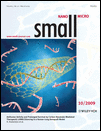Fabrication and Characterization of Graphitic Carbon Nanostructures with Controllable Size, Shape, and Position
Abstract
The incorporation of carbon materials in micro- and nanoscale devices is being widely investigated due to the promise of enhanced functionality. Challenges in the positioning and addressability of carbon nanotubes provide the motivation for the development of new processes to produce nanoscale carbon materials. Here, the fabrication of conducting, nanometer-sized carbon structures using a combination of electron beam lithography (EBL) and carbonisation is reported. EBL is used to directly write predefined nanometer-sized patterns in a thin layer of negative resist in controllable locations. Careful heat treatment results in carbon nanostructures with the size, shape, and location originally defined by EBL. The pyrolysis process results in significant shrinkage of the structures in the vertical direction and minimal loss in the horizontal direction. Characterization of the carbonized material indicates a structure consisting of both amorphous and graphitized carbon with low levels of oxygen. The resistivity of the material is similar to other disordered carbon materials and the resistivity is maintained from the bulk to the nanoscale. This is demonstrated by fabricating a nanoscale structure with predictable resistance. The ability to fabricate these conductive structures with known dimensions and in predefined locations can be exploited for a number of applications. Their use as nanoband electrodes is also demonstrated.




